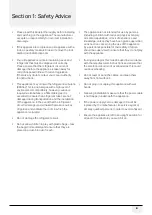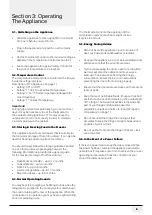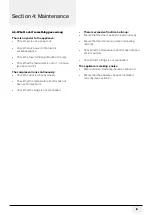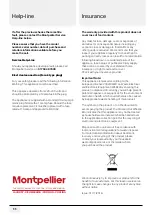
6
Section 3: Operating
The Appliance
3.1. Switching on the Appliance
•
Allow the appliance to stand upright for a minimum
of 4 hours before you switch it on.
•
Plug in the appliance and switch on at the mains
supply.
•
Set the thermostat control to the required setting as
detailed in the Temperature Control section (3.2.).
•
Leave the appliance for approximately 4 hours for
the correct temperature to be reached.
3.2. Temperature Control
The temperature selector knob is located on the r/h wall
inside the refrigerator (see
Description of the Appliance on page 1).
•
Setting “0ff”: Unit Off
•
Setting “1”: Unit On – Warmest Temperature
•
Setting “3” to “4”: Normal Operation (adequate for
most situations)
•
Setting “7”: Coldest Temperature
Important!
During high ambient temperatures e.g. on hot summer
days, it may be necessary to set the thermostat to
the coldest setting (position 7). This may cause the
compressor to run continuously in order to maintain
a low temperature in the cabinet.
3.3. Storing & Freezing Food in the Freezer
This appliance has a four star freezer that is suitable for
the long-term storage of frozen food items. It can also be
used for freezing and storing fresh food items.
You should always follow the storage guidelines printed
on each food producers packaging, however the
following information is provided as a general guide
for the maximum storage life of frozen items:
•
Fresh Meat and Poultry – up to 12 months
•
Cooked Meats – up to 2 months
•
Fresh Fish – up to 6 months
•
Fruit and Vegetables – up to 12 months
•
Bread and Cakes – up to 6 months
3.4. Normal Operating Sounds
You may hear faint gurgling or bubbling sounds when the
refrigerant is pumped to the cooling system and through
the coils or tubing at the rear of the appliance. When the
compressor is in operation you may hear a slight whirring
sound or pulsating noise.
The thermostat controls the operation of the
compressor, and you may hear a slight click as
it cycles in and out.
3.5. Energy Saving Advice
•
Do not install the appliance close to sources of
heat, such as a cooker,dishwasher or radiator.
•
Locate the appliance in a cool well-ventilated room
and make sure that the air vents are clear.
•
Try to avoid keeping the doors open for a long time,
warm air will enter the cabinet and may cause a
build-up of ice as well as affecting the energy
consumption. Ensure there are no obstructions
preventing the doors from closing properly.
•
Ensure that the door seals are clean and there are no
tears or splits.
•
Keep the most perishable foods, (those with a short
shelf-life, such as cooked meats), in the coldest part
of the fridge. The Salad Crisper Box is the warmest
part of your fridge and should be used for
vegetables, salads and fruits etc. (see Description
of Appliance on Page 1)
•
Do not overload the fridge: the cooling air that
circulates to keep the fridge cold gets blocked and
pockets of warm air form.
•
Do not put hot food into the fridge or freezer – let it
cool down first.
3.6. In the Event of a Power Failure
If there is a power failure, keep the doors closed. When
the power has been restored the appliance will start to
operate but it may take some time to achieve the pre-set
operating temperature. Check the condition of your
stored food items and liquids.
Summary of Contents for MAB2030K
Page 10: ...Notes 9...
Page 11: ...Notes 10...






























